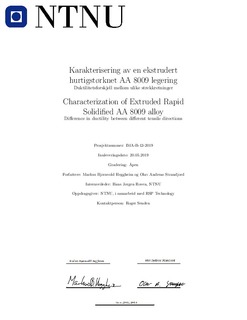| dc.contributor.advisor | Roven, Hans-Jørgen | |
| dc.contributor.author | Heggheim, Markus Bjørnvold | |
| dc.contributor.author | Strandjord, Olav Andreas | |
| dc.date.accessioned | 2019-08-25T14:00:33Z | |
| dc.date.available | 2019-08-25T14:00:33Z | |
| dc.date.issued | 2019 | |
| dc.identifier.uri | http://hdl.handle.net/11250/2610716 | |
| dc.description.abstract | I denne bacheloroppgaven var hensikten å finne årsaken til at den hurtigstørknende aluminiumslegeringen RSA AA 8009 hadde ulik bruddforlengelse på langs enn på tvers av ekstruderingenretningen. For å finne mulige årsaker til dette ble det sett på prøver i lysmikroskop og SEM både på langs og på tvers. Det som kom av bildene både fra lysmikroskop og SEM var at det var for det meste en fin struktur, men at det lå lange mørke faser i langsretningen, mens i tversretningen var det små mørke prikker. For å finne ut hva disse mørke områdene bestod av ble det brukt EDAX, som viste at det var rent aluminium. Områdene rundt bestod av aluminium pluss legeringselementene til denne legeringen. Det var altså rene aluminiumsfaser som lå i langsretningen. Det ble da kjørt strekktester, med prøver tatt både på langs og på tvers av ekstruderingsretningen. Her viste det seg at prøvene tatt på tvers, ga sprø brudd med omtrent 5% forlengelse, mens prøvene på langs ga duktile brudd med omtrent 12% forlengelse.
Da rent aluminium vil være mer duktile enn fasene rundt det oppstå problemer. Kravet til kompatibilitet vil da føre til at det dannes defekter i grensesjiktet rundt aluminiumsfasene, og dette vil gjøre grensesjiktet sprøtt. Da det er større volumfraksjon av rent aluminium på langs av ekstruderingsretningen vil det bety større områder som blir sprø. Når en prøve tatt på tvers av ekstruderingsretningen vil bruddflaten bli på langs av ekstruderingsretningen. Her vil det bli store nok områder som blir sprø, og prøven vil gå til ett sprøtt brudd. For prøver tatt på langs vil det være såpass små områder som blir sprø, og det vil ikke være nok til at bruddet blir sprøtt. Her vil det da bli duktile brudd.
Bruddoverflaten til de sprø bruddflatene ble på skrå, omtrent 45 grader og ikke 90 grader på tversretningen. Dette forekommer av at avstanden mellom de rene aluminiumsfasene er kortere 45 grader på enn 90 grader på tversretningen. Bruddet vil forløpe seg ved at det "hopper" til nærmeste aluminiumsfase, og dermed bli omtrent 45 grader. | |
| dc.description.abstract | In this bachelor's thesis, the purpose was to find the reason why the rapidly solidified aluminum alloy RSA AA 8009 had different elongation along than across the extrusion direction. In order to find possible causes for this, samples were studied in light microscope and SEM, both along and across the extrusion direction. The pictures from both the light microscope and the SEM showed that it was mostly a fine structure, but that there were long dark phases in the longitudinal direction, while in the transverse direction there were small dark dots. To find out what these dark areas consisted of, EDAX was used, which showed that it was pure aluminum. The surrounding areas consisted of aluminum plus the alloying elements of this alloy. Tensile tests were then run, with samples taken both longitudinally and across the direction of extrusion. The results was brittle fracture for samples across the direction of extrusion with approximately 5% elongation, while samples along the direction of extrusion gave ductile fractures with approximately 12% elongation.
Since pure aluminum will be more ductile than the phases around, problems will arise. The compatibility requirement will then cause defects in the boundary layer around the aluminum phases, and this will make the boundary layer brittle. Since there is a larger volume fraction of pure aluminum along the direction of extrusion, it will mean larger areas that become brittle. When a sample taken across the direction of extrusion, the fracture surface will be along the length of the extrusion direction. Here, there will be large enough areas that become brittle, and the sample will go to a brittle fracture. For samples taken alongside, there will be so small areas that become brittle, and it will not be enough for the fracture to become brittle. Here there will then be ductile fracture.
The fracture surface of the brittle fracture surfaces was approximately 45 degrees and not 90 degrees in the transverse direction. This occurs because the distance between the pure aluminum phases is shorter 45 degrees than 90 degrees in the transverse direction. The fracture will occur as it "jumps" to the nearest aluminum phase, and thus becomes about 45 degrees. | |
| dc.language | nob | |
| dc.publisher | NTNU | |
| dc.title | Karakterisering av en ekstrudert hurtigstørknet AA 8009 legering - Duktilitetsforskjell mellom ulike strekkretninger | |
| dc.type | Bachelor thesis | |
